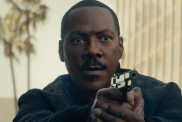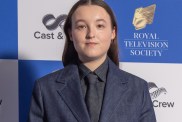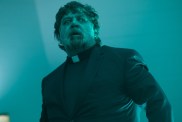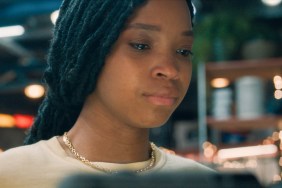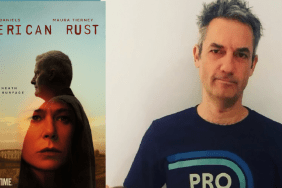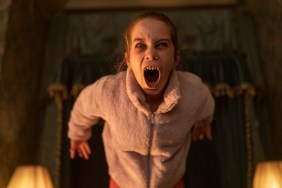Having grossed more than $585 million at the worldwide box office, DreamWorks Animation’s prehistoric family adventure The Croods is coming to DVD and Blu-ray this week and ComingSoon.net had the opportunity to sit down with directors Chris Sanders and Kirk DeMicco to discuss the long road they traveled to bring Grug and his family to the big screen.
Featuring the voice work of Nicolas Cage, Ryan Reynolds, Emma Stone, Catherine Keener, Clark Duke and Cloris Leachman, The Croods follows the adventures of a primitive family learning to survive in a fantastic (but dangerous) stone age world.
Sanders (with Dean DeBlois) directed Lilo & Stitch and How to Train Your Dragon while DeMicco helmed the animated adventure Space Chimps. In the below interview, the pair talk about how they came together for The Croods, the tremendous amount of world-building that went into the film’s bizarre creatures and exotic environments and what ideas they may already have for The Croods.
CS: It seems to be fairly common in animation for directors to work in pairs. How did the two of you become creative partners on “The Croods”?
Kirk DeMicco: When I started, I was writing on it. I was a writer here at DreamWorks. We started writing on it in like 2004. This project was originally going to be done with Aardman when we were working with them. Then they left when Sony changed their deal, but Jeffrey [Katzenberg] always believed in the idea. It wasn’t until Chris came over from Disney in 2007, though, that it really got started again. At that time, Chris was directing and I was writing. Halfway through our first goal to make the movie, Chris got pulled to work on “How to Train Your Dragon.” He went off to do that and, in the interim, I came on “The Croods” and became co-director. In that respect, it was a pretty natural thing to work together in a lot of ways because of the fact that Chris comes from storyboard and I come from screenwriting. He writes screenplays as well, but I think we both complimented that part of it. We had different sort of ways of dealing with problems that would come up making the movie.
Chris Sanders: I think one of the reasons you do see, like you’re saying, pairs of directors on animated films is because it’s such a long process and there’s so, so much to do. There’s so many different departments. It takes so much work. It also helps to have a sounding board so someone can kind of remind you of what the intent was from the very beginning. You can’t imagine how many things there are to look at when you consider that every single thing in “The Croods” is made by hand.
DeMicco: Every leaf. Every twig. Every piece of gravel. Sometimes it just comes down to getting another pair of eyes on the screen at all times. We constantly catch things that the other one misses, which is fantastic.
CS: Do you ever make the effort to embrace creative conflict between the two of you to see where it takes you?
Sanders: Well, yes and no. I think we try to iron through that when we first sit down to work on the movie. We outline the movie together. Once you’ve got that outline set down, you do want different voices. For example, we divvy up sequences so I’ll take, maybe, the hunting sequence and maybe Kirk will take the target sequence and we both jump in and start writing those. Now, that’s a case where having a different voice does make everything better because Kirk would not write a sequence exactly the same as I would.
DeMicco: But, as long as we’ve outlined the movie together and we know that, in sequence five, this and this and this have to happen, it may not get there the same way I would do it, but it nonetheless fits the movie.
Sanders: I think that’s true. Not every pair of directors, at least at DreamWorks, are also the writers. When we’ve written the script, we kind of already have that. When we go out and record, we very rarely go, “Oh, but I saw that line differently.” We’re rarely fighting over the material because it’s our material. We kind of know it pretty quickly when we hit the mark.
CS: You mention that it has been a very long road bringing this to the big screen. What’s the biggest change that “The Croods” went through between its inception and the final product?
Sanders: From my perspective, when I came onto this, it was a village and there were things about the movie that just wouldn’t get off the ground. We felt like we had worked for about a year and had done everything we could to the outline to make it work. It didn’t lift off. It just didn’t get off the ground. It was just too heavy. When I was gone on “How to Train Your Dragon,” Kirk was the one who said, “You know, we’ll unplug just one family from this community and make the movie just about them.” That was the biggest change and that was the key to make this movie work. Making it about one single family. The last family, as far as we know, on Earth.

CS: Can you tell me a little about the world-buildling process? It’s cavemen, but it’s more a fantasy take on cavemen.
Sanders: That was something, when we started doing visual development and stuff and were writing these scenes, we were very into the idea of making our own world. That was something that stemmed from the original talks with Jeffrey. Make it an original world. This is the Croodaceus era. It’s a period of time that we invented. For me, the point of that that worked so well is that we’re following a family through a road trip and they’re constantly amazed by what they see. They’re going through uncharted territory and we thought it was important for the audience to also be discovering things with them. When you’re going through that world watching it, you don’t know what those creatures are, either. There’s certain things that pop up that you really know are dangerous, but there’s also things like the birds. You think, “Oh, it’s just birds,” but then you see how they eat. We kept on surprising them and I think that helped to make it pretty clear that Grug was, obviously, very protective and afraid of the outside world. He’s not crazy. The outside world in the film is very dangerous. I think that was a big part of it and it freed us up to have more fun. We would kind of keep things grounded, though. All the textures in our movie are very realistic. Textures on the leaves. Textures on the trees. We would play these kind of games where we would just ask, “What if the shape of the tree was off just a tiny bit more?” Then we would make the surfacing more real. There’s a very fine line between having yourself grounded in the strange and, say, going to Dr. Suess-land. We ran the risk of getting too Suess-ical and we would kind of lose that sense that this family could be in danger. It was just too whimsical in a way. I think that became one of the hardest challenges of the film.
CS: To that same point, where do you begin when designing this realistic-but-fantastic creatures?
DeMicco: We have a very, very talented designer here. His name is Takao Noguchi and we partnered with him to take the lead in giving the animals a consistent vibe. Whether or not they’re deadly or friendly, we want them to be appealing. Takao has such an incredible ability to do that. That said, we wanted this world to be one where the audience is in the same place as the Croods are. Whenever you see an animal, usually, at first glance, you can’t really peg it as a dangerous animal or a non-dangerous animal. That’s on purpose. We wanted everything to seem fascinating initially, like the little red birds that pop up out of the ground. They look kind of pretty until they massively become this 20,000 bird flock and start behaving like piranhas. That was the design principle. To keep them all appealing looking. A lot of the animals are combinations of two different animals that we might recognize. We thought that our method of going backwards in time meant that we could take animals we know today and combine them. As time moved forward, they either separated and became the animals we know today or they disappeared altogether.
CS: It has to be a fun part of an animator’s job to create monsters. For you, Chris, that sort of goes back to “Lilo & Stitch” and “How to Train Your Dragon” as well. Do you think every animator has their inner Ray Harryhausen?
Sanders: Absolutely. I think that’s one of the things you look forward to. You hope to work on fantastic things and creatures when you get into animation in the first place. With a movie like this, you really can’t make too many. That is very, very exciting and really genuinely fun. It’s a very welcome challenge to take on all that animation. From an animator’s point of view, they get to take a look at the movement of the creature and figure out what its role in the film is. How is it going to behave? The punch-monkeys, for example — the little monkeys with the giant fists — those must have been really, really fun to animate. I sometimes wish we had a little more time to spend with the animators because I’m always very curious to find out what kinds of problems they might have had and how they solved them.
CS: In the creature design process, was there anything that didn’t make it because it was just too weird?
Sanders: Not to weird. We had animals that were very, very big. It’s just that, when you’re making these kinds of films, you run out of time. That’s the hardest thing. Time is money and you run out of time. We had animals that were on the edge of being in the film, but they would come and go depending on which way the story turned.
DeMicco: We had a giant cat-fish that was actually like a cat and a fish. The fish-cat. He was great. He kept on coming in and then he’d be gone. We’d talk to the team and they’d go, “Is my character still in?” and we’d be like, “Yeah. This week it is.” Next week it would be, “Oh, sorry. It’s not.” We didn’t want to just cram them in there.
CS: It sounds like we’ll be seeing more of the Croods before too long. What’s the state of the sequel?
Sanders: There’s not much to talk about yet because we’ve got a big lump of clay and we’re forming it as we speak.
DeMicco: We just started talking with Jeffrey about it really like this week. Lots of good creatures. We’ve got creatures that never got into the first movie. We’re going to take a very, very close look at those.
Sanders: I know Emma [Stone], Nic [Cage] and Ryan [Reynolds] are all coming back, so we’re psyched about that. We’re looking forward to that.
